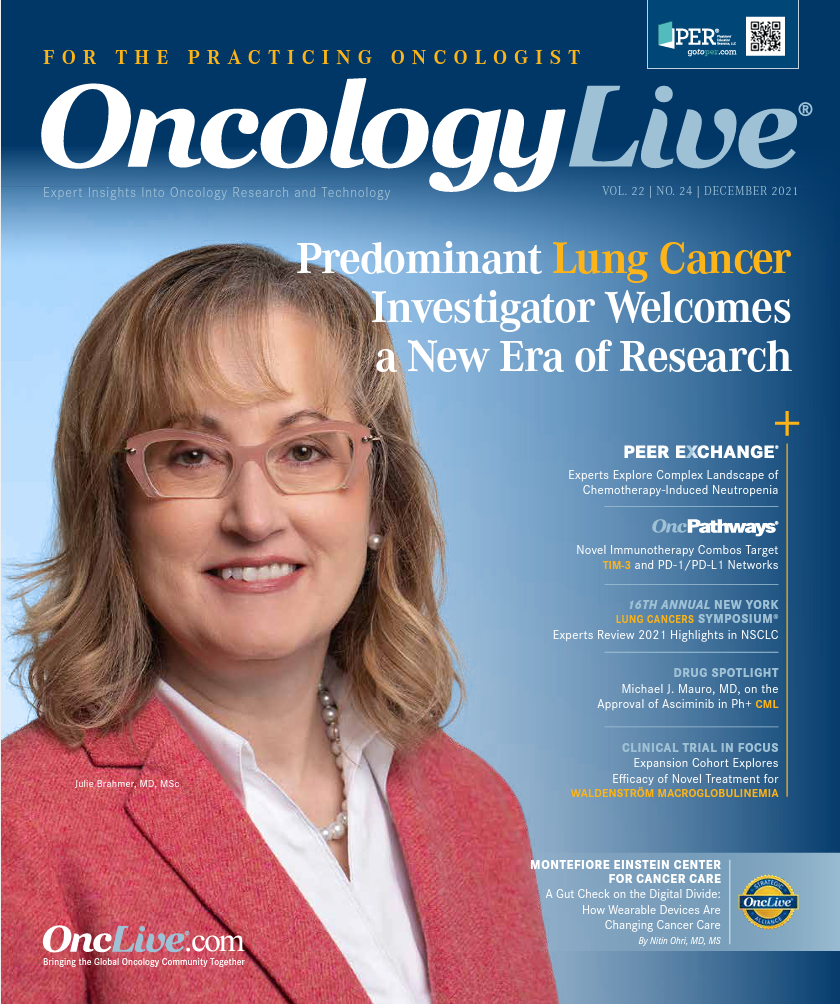Publication
Article
Oncology Live®
Investigators Navigate the Complicated Treatment Landscape of Chemotherapy-Induced Neutropenia
Author(s):
Advances in the treatment of solid tumors and hematologic malignancies have resulted in the development of thera-peutic regimens that can be administered at various points in a patient’s care.
Rita Nanda, MD

Advances in the treatment of solid tumors and hematologic malignancies have resulted in the development of thera-peutic regimens that can be administered at various points in a patient’s care. However, as patients’ disease progresses, adverse effects (AEs) from initial standards of care or second- or later-line may limit the ability of a patient to pursue addi-tional treatments. Neutropenia is a common complication of chemo-therapy that increases the risk of serious infections and fever and may require adjustments to patients’ chemotherapy schedules, potentially affecting their early and long-term outcomes. “It can be quite challenging in clinics to [treat], prevent, anticipate, and then keep patients on track in terms of their curative chemotherapy or therapy that’s helping to extend life and keep their symptoms under control,” Rita Nanda, MD, said during a recent OncLive Peer Exchange®.
Nanda was joined by a panel of breast cancer experts to discuss this high-stakes complication, which may be encountered more frequently in patients with breast cancer than other tumor types as risk of neutropenia tends to increase with increas-ing treatment lines. “We see it in breast cancer because we’re [treating] patients in the sixth-, seventh-, or eighth-line setting,” Tiffany A. Traina, MD, explained. During their discussion, the panelists shared their experiences with chemotherapy-induced neutropenia (CIN) and provided insights on its risk factors, when to intervene, use of granulocyte colony-stimulating factors (G-CSFs), and the unique challenges associ-ated with these agents.
Tiffany A. Traina, MD

Defining CIN
A patient is generally considered to have CIN when their absolute neutrophil count (ANC) count is less than 2000 cells/µL.1 This toxicity is then further classified into grades based on severity (TABLE 11,2). Nanda said she considers CIN to be any ANC level that would preclude her from providing a patient with their planned treat-ment. In most cases, she said this is an ANC level of 1000 cells/µL or less. It is at this threshold when the most severe form of neutropenia, febrile neutropenia, may manifest.3 The National Cancer Institute’s Common Terminology Criteria for Adverse Events version 5.0 characterizes chemother-apy-induced febrile neutropenia (CIFN) as an ANC level less than 1000 cells/µL and a single temperature of higher than 38.3 °C (101 °F) or a sustained temperature of at least 38 °C (100.4 °F) for more than 1 hour.3
TABLE 1. Commonly Used Cutoffs for CIN Grading

Risk Factors For CIN
“It’s not always entirely predictable in whom [CIN] is going to occur,” William J. Gradishar, MD, said. He explained that there can be variability, even among patients receiving the same treatments. Nevertheless, he said that some regimens may increase the risk of CIN, including dose-dense anthracycline-based regimens and docetaxel and other taxanes, particularly when administered as part of a combination regimen.
William J. Gradishar, MD

Traina noted that there are many patient- and disease-related risk factors for CIN, including older age (≥ 65 years), compromised organ function (eg, elevated bilirubin levels), low body surface area or low body mass index, low baseline white blood cell counts, presence of more advanced disease and/or more compromised bone marrow, and increasing treatment lines. “There is literature around certain SNPs [single nucleotide polymorphisms] that may predispose to neutropenia, depending on the regimen being used,” she said.
For example, in a study of patients with breast cancer who were treated with 5-fluorouracil, epirubicin, and cyclophosphamide in the phase 3 SUCCESS-A trial (NCT02181101), 3 SNPs in HMMR were found to be significantly associated with neutropenia.4 All 3 of these SNPs were transexpression quantitative trait loci for the expression of TNFSF13B, encoding the cytokine B-cell activating factor. However, Traina said that SNP findings are not yet actionable but the hope is that they may eventually lead to the identification of biomarkers predictive of CIN risk.
The panelists noted that although CIFN is uncommon in their practices, it still occurs. A risk factor for CIFN is the use of corticosteroids, with longer-term use and more recent use of these agents reported to increase the risk of CIFN 3-fold and 2-fold, respectively.5 Additionally, certain dermatologic and mucosal conditions (eg, gastritis, dermatitis, psoriasis), as well as the use of intravenous antibiotics, but not oral antibiotics, before chemotherapy, have been associated with a higher risk of CIFN during the first chemotherapy cycle. It has been suggested that these factors should be considered in prophylaxis use and CIFN prediction modeling.5
CIN Prophylaxis Reccomendations
The National Comprehensive Cancer Network (NCCN) guidelines recommend that all patients with solid tumors and nonmyeloid malignancies be evaluated for their risk of CIFN before their f irst chemotherapy cycle.6 The risk assessment should consider patients’ disease; chemotherapy regimen, including intensity (eg, high-dose, dose-dense, or standard-dose therapy); individual patient risk factors; and treatment intent (ie, curative vs palliative). Based on these findings, patients are classified into a high-, intermediate-, or low-risk category, which guides the use of William J. Gradishar, MD prophylactic G-CSFs (TABLE 26).
TABLE 2. NCCN Recommendations for Prophylactic Use of G-CSFs for CIFN in the Curative/Adjuvant or Palliative Setting

Traina explained that these are recommendations for primary prophylaxis. “Obviously, we’re all very comfortable once you’ve gone to treat a patient on, say, day 1 of a cycle, and they present with limiting neutropenia, then incorporating growth factor in that secondary prophylaxis setting, [which] is often preferred to keep patients on schedule at an appropriate dose and intensity,” she said.
Though the NCCN guidelines provide guidance on preventing CIFN following the first round of chemotherapy, they do not address CIFN risk after patients start chemotherapy. “It’s important for us to understand when patients are at their greatest risk for CIN, which is after they start chemotherapy. That’s something our patients also want to know, in terms of what their risk is if they’re going to travel or work,” Hope S. Rugo, MD, FASCO, said.
Hope S. Rugo, MD, FASCO

Rugo explained that with most regimens neutropenia occurs 7 to 10 days after chemotherapy is administered, though risk of CIN may be prolonged when drugs with a longer half-life are used, such as platinum agents. “We worry a lot about infections when [a patient] has grade 4 neutropenia with a neutrophil count fewer than 500 per µL, whereas we’ll see patients with a neutrophil count of 980 per µL, which is fewer than 1000 per µL but not worrisome….There’s some risk, but with fewer than 500 per µL there’s an even greater risk,” she said.
Nanda said clinicians should have a low threshold on when to integrate prophylaxis into their regimens, particularly during the COVID-19 pandemic. “In this era of COVID-19, we need to be aggressive about trying to prevent neutropenia and neutropenic fevers because hospitals are not great places for our patients to be right now, and emergency departments are even more challenging [environments]. Preventing neutropenia and preventing neutropenic fevers is even more critical for our patients,” she emphasized.
Using Growth Factors in Clinical Practice
The panelists explained that the supportive measures used today, such as growth factors, have helped eliminate or at least significantly reduce the risk of many of the toxicities observed in the past, such as mouth sores and typhlitis. “The most common symptoms we see are the sequalae from the chemotherapy, low-grade fevers, or flu-like symptoms,” Gradishar said. “The typical AEs that would have been more common at the early part of our careers are infrequent.” Nevertheless, he warned that there are rare patients who may still experience profound neutropenia in the immediate period after chemotherapy before their blood counts recover, which can be catastrophic.
Traina recently encountered such a patient, a woman in her late 60s treated with docetaxel/cyclophosphamide (TC) in the adjuvant setting. She said the patient was hospitalized with neutropenic colitis after her first treatment cycle. Based on her experience, Traina said she is very sensitive to risk factors and using growth factors as prophylaxis for any patient with a high-risk feature.
Gradishar agreed and indicated that, although chemotherapy regimens have improved and become more tolerable overall, there are still regimens that warrant the use of G-CSF prophylaxis, including some requiring a long-acting G-CSF such as pegfilgrastim (Neulasta). “With TC we [give pegfilgrastim]. With AC [doxorubicin hydrochloride/cyclophosphamide], we [give it] every other week. [With] weekly paclitaxel, we don’t. We don’t use TAC [docetaxel/ doxorubicin hydrochloride/cyclophosphamide],” he explained.
The panelists also noted differences in their G-CSF prophylaxis practices in the curative/adjuvant setting vs the metastatic setting. Rugo said she still tends to use growth factors in the metastatic setting “to keep [patients] on schedule in part because they do better and secondly because it’s a nightmare to reschedule everybody all the time,” but that they might change the schedules to every other week.
Gradishar and Traina both said they tend to be less rigid about patients staying on their chemotherapy schedules in the metastatic setting because the focus is more on palliation. “There’s a real inconvenience aspect [to] self-injection or having to come into the clinic for daily growth factor injection,” Traina said. “In the palliative setting, that’s not where I want my patients spending their time. I don’t want them to be in the hospital or the clinic. I’m with [Dr Gradishar], adjusting schedules and doses perhaps a little more liberally in that setting.”
Nanda said that she also considers patients’ past experiences to determine the need for G-CSF in the metastatic setting. “If I have patients who’ve been on chemotherapy drugs that generally aren’t associated with needing growth factor but they needed it, then a lot of times I will preventively use it when they move on to subsequent lines of therapy,” Nanda said. “There are cases in which I’ll even preventively use it in the advanced cancer setting, particularly for patients who have a heavy disease burden and have struggled with therapies in the past that most [patients] don’t struggle with.”
Mitagating Challenges Associated with G-CSF Treatments
Although treatment with G-CSFs is generally well tolerated, they are associated with several toxicities, including bone pain. Rugo explained that bone pain is more common in patients with naïve bone marrow but that some patients “seem to get it all the time.” In patients with bone pain, an important step is for clinicians to determine its cause, including whether it is related to the patient’s chemotherapy regimen or to the growth factor support, especially because bone pain can be mistaken for a myocardial infarction or other complications and lead to unnecessary hospitalizations and procedures.
“I have a patient who has von Recklinghausen neurofibromatosis and a bunch of other things, including...ER [estrogen receptor]–positive early-stage breast cancer,” Rugo said. “She has had severe bone pain and went to the emergency department, where [she received a diagnosis of] pericarditis. I pointed out that she didn’t have that, but they didn’t believe me—she just had this drug-induced pain. Consequently, we’re working around that, but it can be a big issue for patients.”
Once it is determined that the bone pain is induced by the growth factor support, Gradishar said he will treat his patients with a course of steroids or antihistamines, as these can be helpful in resolving the pain in some cases. Rugo agreed and said that she usually prescribes nonsedating antihistamines. Although they work variably, and the mechanisms by which they improve bone pain remains unclear, she said these agents have “little downside” because they are “cheap and nontoxic.”
Because bone pain from G-CSFs usually occurs quickly after their administration, Nanda said that she forewarns her patients about this complication and advises them to take over-the-counter (OTC) anti-inflammatory medications if they notice any pain. Then, if the OTC treatment does not work, they are advised to call the office so that they can be prescribed steroids. Another challenge the panelists discussed is delivery of G-CSF via an on-body device. Although these devices spare patients from returning to their doctor’s office the day after their infusion, they come with other restrictions. Traina noted that patients with such devices can’t have imaging done, which may lead to other care challenges and make it difficult to travel if they need to fly. Additionally, the on-body devices do not provide flexibility in dosing and there may be drug delivery issues in some patients.
“Clinicians would often give different amounts of pegfilgrastim if [patients] didn’t need the full dose, but with the on-body device, we can’t do that,” Rugo said. “Additionally, I’ve had a very overweight patient for whom I don’t think the drug was delivered. She kept getting profound neutropenia, and then as soon as we switched to the injection, on day 2 it went away.”
Refrences
- Ba Y, Shi Y, Jiang W, et al. Current management of chemotherapy-induced neutropenia in adults: key points and new challenges: Committee of Neoplastic Supportive-Care (CONS), China Anti-Cancer Association Committee of Clinical Chemotherapy, China Anti-Cancer Association. Cancer Biol Med. 2020;17(4):896-909. doi:10.20892/j.issn.20953941.2020.0069
- Sapkota B, Shrestha R, Chapagai S, Shakya DK, Bista P. Validation of risk of chemotherapy-induced neutropenia: experience from Oncology Hospital of Nepal. Cancer Manag Res. 2020;12:3751-3758. doi:10.2147/CMAR.S243916
- Common Terminology Criteria for Adverse Events (CTCAE) version 5.0. National Cancer Institute. November 27, 2017. Accessed November 22, 2021. bit.ly/3nFlRPp
- Bidadi B, Liu D, Kalari KR, et al. Pathway-based analysis of genome-wide association data identified SNPs in HMMR as biomarker for chemotherapy-induced neutropenia in breast cancer patients. Front Pharmacol. 2018;9:158. doi:10.3389/ fphar.2018.00158
- Family L, Li Y, Chen LH, Page JH, Klippel ZK, Chao C. A study of novel febrile neutropenia risk factors related to bone marrow or immune suppression, barrier function, and bacterial f lora. J Natl Compr Canc Netw. 2018;16(10):1201-1208. doi:10.6004/jnccn.2018.7051
- NCCN. Clinical Practice Guidelines in Oncology. Hematopoietic growth factors, version 4.2021. Accessed November 23, 2021. bit.ly/2Zg5teH

Latest Conference Coverage

Zongertinib Elicits Durable Responses in Pretreated Advanced HER2-Mutant NSCLC

Lenvatinib Shows Efficacy in Advanced HCC Post-Progression on Atezolizumab/Bevacizumab

Sacituzumab Govitecan Does Not Significantly Improve OS in Pretreated Urothelial Carcinoma

Active Monitoring Is Noninferior to Guideline Concordant Care in Low-Risk DCIS
2 Commerce Drive
Cranbury, NJ 08512





